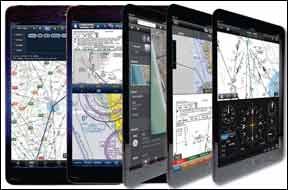Aviation tablet apps, of which there are dozens, have become like the proverbial streetcar. If you don’t see one you like, hang around; another will be along shortly. Or at least the one you’re considering will morph into something unrecognizable if you wait long enough. Pity the would-be buyer trying to sort through the clutter and claims.
In this review, we’ll attempt to do just that with what we consider to be the five top apps for flight planning, navigation and chart handling:
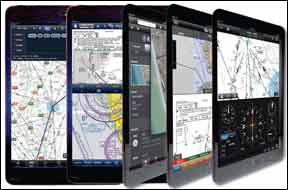
Bendix/King’s myWingman, AOPA’s FlyQ EFB, ForeFlight, Garmin’s Pilot and WingX. Yes, there are others, including Anywhere Map’s Freedom and Jeppesen’s Mobile FD, to name two. We’ll get to these in a future issue, but to keep the topic contained, we’ll examine only the apps we deem most popular based on sales and expressed reader interests.
For our evaluation, we ran the apps on an iPad mini and although we’ve tried accessories such as Bluetooth ADS-B boxes, the only peripheral we used for this evaluation was Garmin’s GLO remote GPS receiver. Two of the apps are available for the Android OS, but we’ll save a review of those for a future report, too. If apps started out as simple flight planners and weather getters, they have evolved into do-it-all navigators and flight libraries, some even including impressive EFIS displays. Except for communications, the most sophisticated apps rival the capability of panel-mount avionics, but at a fraction of the cost. For many buyers, they have displaced the dedicated portable GPS.
Although the apps we’re reviewing here are closely matched in fundamental capabilities such as flight planning and filing, weather briefing, basic navigation and inflight weather display, they vary considerably in sophisticated higher-level features such as terrain display, mapping detail and customization. There are differences in cost, too, but in our view, these are less of a purchase driver than overall features and ease of operation.
For that reason, we’re comfortable saying you won’t go wrong with any of these apps. As our rating chart here shows, they’re close in capability and performance, but it’s in our charter to make picks and recommendations, so herewith are our findings.
Price Comparison
A word about pricing, which is hardly consistent from app to app. WingX, for instance, is the high-priced spread, as shown in our comparison chart. It has the most features of any of the apps, but pricing is à la carte, so you pay for add-ons like synthetic vision and fuel price data.
ForeFlight, on the other hand, throws in the fuel data for its standard price of $74.99 a year and so do Garmin and Bendix/King. Garmin, on the other hand, charges extra for its SafeTaxi data feature, while ForeFlight includes a similar feature as standard with its $149.99 geo-referenced package. Yet when you add everything up, Garmin’s price is cheaper. Other apps, say Bendix/King’s myWingman, may charge more, but don’t have the same or equivalent features. If you’re price shopping on apps, click off the features you want, then total it up before buying.
One last point: The apps business is subscription based, which means the providers make their money by selling you data subscriptions. When the sub expires, so does the app’s functionality, but with two exceptions in this group of apps: WingX and Garmin Pilot continue to function with an expired subscription and they’ll note where and when charts are expired, but still allow you to use them. WingX loses some of its high-level functions, but the basics remain.
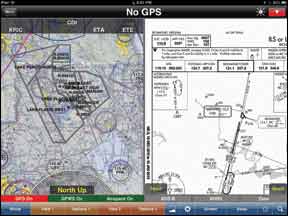
WINGX
As the principle product of Hilton Software LLC, WingX qualifies as one of the original apps, having first appeared in 2004 in Windows Mobile. We’re picking it as the top app in this group because it has the widest and most sophisticated featureset, it’s relatively easy to learn and it’s customer centric, running on an expired subscription.
Like all of the apps, WingX covers the basics, including flight planning and filing, weather retrieval and imagery and inflight navigation. In our view, WingX has two exceptional strengths. It works with the broadest array of remote devices such ADS-B weather and traffic and even as the Levil Technology AHRS if you want EFIS and synthetic vision on an iPad. (We don’t particularly because of the gadget hassle factor, but if you do, WingX has it.)
Second, WingX’s moving map functions are the most complete and flexible of all the apps. It uses a two-screen format—which can be combined to one or swapped—to display a range of choices from sectionals, to approach plates, to low-altitude IFR enroute charts and a detailed terrain map. Customizing the maps is handled through a series of labeled keys at the bottom of the screen, one of which offers the choice of the basic map, the other the ability to customize such details as obstacles, graphic METARS, runway finders and so forth on each map. But you don’t have to move the maps to set the overlays, as with myWingman.
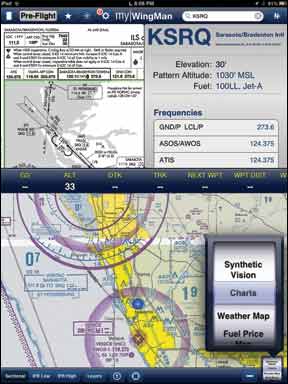
Like Garmin’s Pilot, the basic structure is a menu-driven home page from which the principle functions can be selected. Or not. In flight, just about everything can be done from one of the map pages. On the mini, the largish, bright buttons are a help.
What does it need? Not much, really. The app is fast and we’ll supported and although it lacks a detailed operating manual, it has good help screens. WingX’s Web site has instructional videos that will bring any user up to speed quickly.
FOREFLIGHT
Along with WingX, ForeFlight is one of the earliest apps and among the best known. It runs only on the Apple IOS and there are no plans to offer an Android version. ForeFlight runs we’ll on the iPhone, a plus because most of us will always have the phone, but the iPad may be elsewhere and not necessarily cellular equipped. Planning and filing on an iPhone is practical and easy.
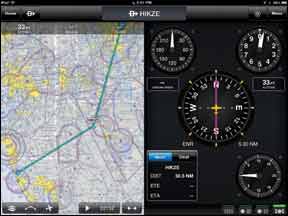
ForeFlight’s strength is in flight planning, especially for the IFR pilot who’s dialed into routing decisions. ForeFlight offers the choice of known preferred routing or actual recently cleared routes, saving you the tedium of inserting fixes you’re unlikely to fly. It also seamlessly inserts SIDs and STARs where appropriate and has an easy-to-use altitude optimizer.
The interface is efficient and no-nonsense. Just type in the departure and destination and ForeFlight instantaneously displays a flight log and fuel required. Touch the brief-and-file icon and it grabs the weather and organizes it in order of importance in textual format. For approach plate handling, you put the plates you want into electronic binders and call them up with a touch of the plate button. As with other apps, the plates are easily scalable and can georeference aircraft position for an upcharge. ForeFlight can plot fuel price data on its map and it doesn’t upcharge for this, while WingX does.
ForeFlight offers two inflight weather options: Appareo’s Stratus ADS-B box and Baron’s XMWX Mobile Link. Both offer a range of weather products, including NEXRAD, but Baron’s is more complete.
ForeFlight’s moving map, while adequate, is not to the level of WingX’s, in our view, at least in terms of details such as terrain display and warnings, runway extensions, synthetic vision and so on. On the other hand, ForeFlight is among the most stable of all the apps. ForeFlight and Garmin’s Pilot were the only two that didn’t freeze up at some point during our trials.
ForeFlight’s support is second to none, in our opinion. The app has a full onboard manual (plus powerful document capability) and the Web site has terrific bite-size training videos. ForeFlight claims “fanatical” support and to test this, we e-mailed the support group early on a Sunday morning and got a response from a real human within four minutes.
What does it need? Possibly split screen. We say “possibly” because the other apps have this and while it is handy for map performance, ForeFlight’s core function doesn’t suffer much without it. And ForeFlight’s loyal users may not miss it.
Garmin Pilot
Anyone who starts diddling with Garmin’s Pilot app may have the vague notion that they’ve seen it before, which is quite intentional. Pilot is modeled on the basic interface of Garmin’s most recent dedicated portable GPS navigators, the aera series. Like WingX, it’s menu driven from a home page. That means when you get stumped, pushing the home key gets you back to mental bedrock.
Pilot’s strength is its moving map and combination navigation display. Like WingX, it has a split screen which can be displayed as a single map with VFR sectionals, IFR enroutes or WACs. These can be overlayed with weather displays, including radar and satellite among 10 choices.
Pilot also offers a version of Garmin’s traditional flight panel, which includes an HSI, an airspeed indicator, an altimeter and a VSI. This display has four customization options. It also sports a G1000-like sidebar with a flight data summary. In our view, no one does this sort of thing better than Garmin.
As with ForeFlight, approach charts go into binders automatically sorted into departure and destination, a nice touch. You also automatically get all of the approach plates, with each thumbnail clearly labeled to be touched and expanded. As with other apps, geo-referencing is an upcharge. For weather and traffic, Pilot plays with the GDL 38 portable ADS-B receiver. (See Aviation Consumer September 2012 for a review.)
What it needs: To meet the ForeFlight standard of support, we would like to see easily accessible training videos for Pilot. It does have a complete manual that’s we’ll indexed.
myWingman
Bendix/King last summer introduced its own app developed with Seattle Avionics, myWingman. Bendix/King’s aim is to gain marketshare generally by introducing avionics that are less expensive and easier to operate than the competition and myWingman is designed accordingly.
Rather than step-through menus or buttons, the app is what Bendix/King calls “flat.” The app’s main control point is a function wheel which appears as a thumbnail in the lower right of the screen. Touching it expands it to reveal an app-style thumbwheel to scroll through nine primary functions. This is not so much easier, in our view, as it is different. But it’s easy to master.
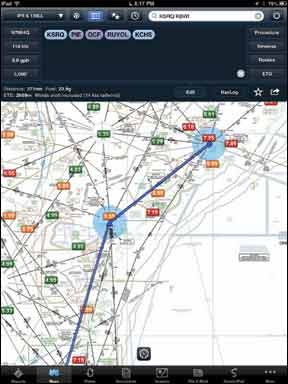
myWingman can have up to three split screens, easily selected from a touch icon in the upper left of the display. However, the function wheel only applies to the bottom screen, so to reset what you want to see, you use two fingers to drag the panel into the lower display, effecting the swap. A novel solution but, again, no better than WingX’s quick-acting swap button. Still, there may be instances where having the third panel, say to look for fuel prices or glance at airport info, would be handy.
Speaking of airport info, both myWingman and FlyQ excel at this. The airport page has high-resolution satellite photos of the runways and surroundings. Map management on myWingman is similar to ForeFlight, but not as sophisticated as WingX. No terrain warnings, runway extensions or on-screen position reports.
Using ForeFlight as the support standard, Bendix/King gets a so-so. We had an issue with setting up a DUAT account and our e-mailed query required a four-day response, compared to four minutes for ForeFlight. Other features include rudimentary synthetic vision and a G-meter, which is mostly a novelty.
What it needs: Maturity, mainly, and more features such as inflight weather. (It’s planned.) This app has been available for only six months and apps constantly improve with each revision. This one bears watching as Bendix/King hears from its users and improves the app on the fly.
AOPA/Seattle FlyQ
The newest app on the block is FlyQ EFB, a joint effort by AOPA and Seattle Avionics, a well-known provider of flight planning software and chart data. FlyQ is an evolution of AOPA’s original FlyQ planner for desktops and smartphones. FlyQ has minor details in common with myWingman, but does most of its functions differently from the other apps.
It features split-screen display and both of those can be configured independently to show sectionals, high- or low-altitude enroute charts or approach plates. But unlike WingX, getting the plate to show in the split requires more of a step through than just a single button. Once configured, viewing a plate in one window and a chart with the active route in the other is easier, but it’s not intuitive getting there, in our view.
This is further frustrated by the lack of the help screens and manuals that the other apps have. It’s not that any of these apps are difficult to figure out, but training support helps reveal the hidden tricks and shortcuts that all of them have, without frustrating trial and error. Also, there aren’t any training videos for FlyQ yet. We would like to see them.
FlyQ offers such high-level features as an onboard EFIS using the Levil Technology box with terrain display. It will also function with just the onboard GPS. As of press time, it has no ADS-B support, but that’s planned. One thing FlyQ excels at is weather presentation. Its dedicated weather page shows thumbnails of local and regional radar, below which are panels with plain language weather color-coded by flight rules, plus winds aloft and a DUAT summary. What it needs: As with Bendix/King, more maturity and definitely better supporting tools that are easy to find. With ForeFlight setting the standard, support can’t be left to chance, even if it’s not needed by everyone.
Recommendations
For the pilot who wants all the features, whether they’ll be used or not, WingX is the one to beat, in our view. It has good map features, plenty of connectivity with ADS-B and its unique data compression makes it both lightning fast and the stingiest of all for storage requirements.
We think it’s the ideal choice for someone who wants an app to function as a portable GPS with weather-getting capability. But it’s not the cheapest app by any mean means. Second choice in this category is Garmin’s Pilot, which is a good option for the same requirements.
For the serious IFR pilot, we think ForeFlight is the hands-down best choice because of how it handles routing and its no-nonsense fast operation bereft of any cuteness. For the technically competent pilot who has a complete panel, ForeFlight is a supporting utility that’s hard to beat. We suspect it will improve more in the coming year as the competition heats up.
As for myWingman and FlyQ, these are both competent apps, but we’ll look at them a year from now to see if we think either of them is worth switching to from another app. For now, we don’t.

